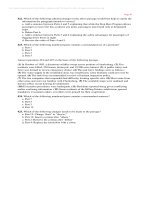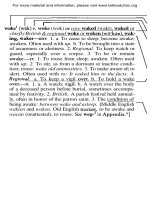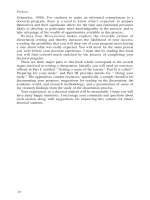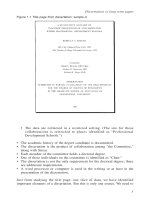Writing your doctoral dissertation - part 23 pdf
Bạn đang xem bản rút gọn của tài liệu. Xem và tải ngay bản đầy đủ của tài liệu tại đây (88.97 KB, 5 trang )
Writing your dissertation proposal
110
and Goetz, 1982; Howe, 1998; Howe and Eisenhart, 1990; Richardson,
forthcoming; and Wittrock, 1986). For instance, when there is a careful match
among the theory being tested, the data collected, and the research question,
there is construct validity—one important type of affirmation that your study
has been carefully designed and implemented. Since one of your major
concerns in conducting this study is to convince experienced researchers that
this is quality research, you will want to provide clear evidence of the validity
of the decisions you made in planning and conducting it. You want to provide
assurance that you have complied with accepted research practices,
discussing, for example, the reliability and validity or the truthfulness of all
the procedures you followed in designing your study.
Another way to establish the validity of your methodology is to seek expert
evaluation. You will want to respond to suggested revisions, either following
the advice offered, or rejecting it. Your correspondence is frequently included
in an appendix to your proposal. An explanation of all the steps you create to
validate your study promotes respect for the quality of your research.
Steps Toward Approval of Your Proposal
There are numerous steps which mark you progress toward approval of your
proposal. You will probably want to include each of these in your personal
checklist and note when each has been fulfilled (see Appendix E).
Once your committee has confidence in your proposal, there is likely to
be a formal proposal hearing. With an approved proposal in hand, you are
ready for two things:
1 Celebrate your major accomplishment. One outcome of this review is a
written approval which you should preserve in a safe place. This statement
certifies the acceptance of your proposal by university reviewers. The
approval theoretically signifies a commitment between the university and
the student to support the completion of your project, providing you adhere
to all the university’s rules, such as registering each semester. But there
are no guarantees. Complete your degree requirements as rapidly as
possible to avoid new rules and expectations which inevitably accompany
new administrations or faculty changes. Celebrate your progress—and…
2 Get on with the next phase of your work—conducting your study!
111
11 Conducting Your Study
By thinking of it as small parts—theoretical rationale, research design, etc. —I
was able to divide the project into smaller, more manageable units and thereby
was able to reduce the pressure on myself, and make it possible to see progress
on this immense project.
One thing the dissertation forced me to do was to reflect on what I was doing.
This time to reflect was a gift.
With your committee’s approval, you are now ready to “do your study.”
This is a most exhilarating time in the research process. It is at this point
that you are able to use your unique talents, experiences, and knowledge.
Your organizational skills ease your way as you both orchestrate this large-
scale study and insure that you have the documentation you need to write it
up. Now is the time when you discover the answer(s) to your research
questions.
Being mindful that you are responsible for establishing your own schedule,
you will create a time line, noting all the activities which need to be done,
and giving adequate time for each step. As you make this list you will identify
several activities which may be accomplished simultaneously. For example,
when you send out questionnaires to one group of participants, you may
schedule and conduct interviews with other participants. There is always
something that can be done. Do not allow one day to go by without doing
something. Your schedule keeps you in focus, as long as you revise it to
reflect the real progress you are making and the added elements which need
to be completed in your study. Expect that your initial projections will be
revised. Don’t allow any curve balls to stop you. They may cause you to take
a new perspective, but keep a positive attitude, finding ways to succeed.
You will have the greatest control over the quality and the progress of your
study if you personally take on responsibility for each part. Keep careful
notes of all your activities as you collect and analyze your data, such as
interview schedules, drafts of survey instruments, and analytical categories.
These notes will be invaluable when you describe each step that you took in
the research process.
There are three major activities integral to the process of conducting your
study:
Conducting your study
112
• collecting and storing your data;
• analyzing your data; and
• interpreting your findings.
Although we will discuss these separately, these are interdependent
components of your study as noted in Figure 11.1. There are times, for
example, when you may analyze some of your data while you are still
collecting further data.
Collecting and Storing Your Data
In your proposal you identified data which you expected to collect and use in
conducting your study. Your data may take many forms. Depending on the
focus of your study, you may collect a range of materials. For example:
census reports unpublished documents
statistical tables test results
interview questions handwritten journals
field notes survey responses
transcripts published articles and letters
photographs video-tapes
personal letters parental approvals
You will need to establish systematic procedures for collecting and storing
these data so that you can find them when you need them.
Collecting your Data
As you start your study you need access to all the materials which you have
identified. The collection process may take the form of visiting libraries and/
or identifying human participants. If you are planning to enlist the
cooperation of others in your data collection (through interviews, responses
Figure 11.1 Conducting your study: a cyclical process
Conducting your study
113
to surveys, or the like), you need to find effective ways to accomplish this.
Remember that the people who are your participants are helping you. There’s
probably nothing “in it” for them except for the feeling that they are helping
you, and/or the research community. Your recognition that your study is
dependent on getting good data from these respondents will be evident in the
ways in which you accommodate your respondents’ priorities. Some
suggestions for encouraging participation in your study are noted below.
Ultimately you must find a way to get people to respond. Without data, your
study cannot go forward. If you run into problems, your committee and
your program colleagues are excellent resources for addressing these
concerns.
If you need to develop a questionnaire for a survey or interviews, you may
find useful resources in other dissertations, published reports of related
studies, conference presentations, or the like. There are also books written
on interview strategies (see Appendix D for suggestions). Your study will be
enhanced by pilot-testing your materials. It is also useful to audio-tape and
then critically review your potential questions. Try to simplify your
procedures for your participants.
Recent studies are increasingly collecting data on video-tapes and
subsequently transcribing some of the verbal interactions. At the present time
there are some software programs which may assist you in transcribing your
data. But they will not replace your keen attention to the exact words uttered
by your participants. Transcribing is laborious, time-intensive, and frustrating.
It is also illuminating and fascinating. If you maintain field notes during the
actual taping, and transcribe your tapes fairly soon after recording, you will
Suggested strategies for gathering responses
• Keep the time needed to a minimum.
• Inform people of the time this is likely to take.
• Arrange a time that is convenient for your participants.
• Provide instructions which are easily understood.
• Insure anonymity and confidentiality where possible.
• Invite assistance from those concerned with the same issue you
are studying, such as members of your professional organization.
• Note in your invitation the names of people on your committee
who are respected by your potential informants.
• Expect that only about 50 per cent of the group of potential
participants may respond.
• Limit the number of participants needed.
• Seek assistance from people you have helped.
• Provide a stamped, self-addressed envelope, when appropriate.
• Follow up on the telephone, by snail mail, or by e-mail.
Conducting your study
114
find it easier to clarify seemingly chaotic data than if many months have
elapsed or if you are absent from the taping experience. The video-tape and
field notes are “raw” data, whereas the transcript is derived from your initial
data. Each transcript represents a specific perspective. As you create your
transcripts and decide what to include, be conscious of your selections and
exclusions, and be ready to explain these decisions in your dissertation and
at your oral examination.
While you are collecting all your data, you want to be as cautious as
possible about restricting your influence on the activities. You want to
maintain a neutral, explorer’s stance, seeking to discover something new as
you collect your data.
Storing Materials
Establish one place to store all your materials, a place no one else will
disturb. As you engage in your data collection and analysis, you are likely
to create numerous stacks of papers. You may have books and journal
articles from the library, blank questionnaires, responses to surveys, new
and recorded audio-and video-tapes, field notes, essays written in classes,
pre-publication articles, email from experts across the nation, conference
papers, and equipment. The more cautiously you store these materials, the
more likely it is that you will be able to retrieve them when you want
them.
You will also need to find ways to categorize the materials you are
accumulating. You might place all your completed questionnaires in one box,
and the names and addresses of people surveyed in a second box. Your
computer diskettes may be organized chronologically, noting the data
collected in the first three months of your study on Diskette #1 and that
collected in the second three months on Diskette #2. One set of back-up
diskettes may be stored near your computer, a second set placed on your
living-room bookshelves, a third back-up in the form of your zip drive may
be carried in your backpack. And of course, keep hard copies as well. Be
paranoid: store your data in many places.
Conducting the actual study can be exciting, as well as frustrating. It can
be exciting if the researcher has organized the procedures for conducting
the study and has enlisted the help of persons to assist in collecting the
data. Even the most organized and well-planned study does not always
go as anticipated, but good organization can help things move smoothly.
It is very important that the researcher set deadlines for receiving data.
There must be some contingency for retrieving data that are not received
by that deadline. Some researchers may have a telephone committee to
remind people to return data. Others may send out letters as reminders.
Of course, much of this will depend on the type of research being
conducted. When experimental research is done, the experimenter has









